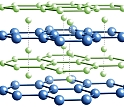News Release 08-011
Lithium and Beryllium No Longer "Lack Chemistry"
Scientists predict antisocial metals will bond under high-pressure conditions

Scientists predict lithium and beryllium will form stable alloys at high density and pressure.
January 25, 2008
This material is available primarily for archival purposes. Telephone numbers or other contact information may be out of date; please see current contact information at media contacts.
Even though the lightest known metals in the universe, lithium (Li) and beryllium (Be), do not bind to one another under normal atmospheric or ambient pressure, an interdisciplinary team of Cornell scientists predicts in the Jan. 24 issue of Nature that Li and Be will bond under higher levels of pressure and form stable Li-Be alloys that may be capable of superconductivity. Superconductivity is the flow of electricity with zero resistance.
The Inorganic, Bioinorganic and Organometallic Chemistry program at the National Science Foundation (NSF) supported the research because little work had been done to predict the properties of metals under high pressure.
"We found that chemists working on inorganic compounds and inorganic reactions under high pressure were interested in the predictions and felt it would stimulate useful interactions between theorists and experimentalists," said NSF Program Manager Michael Clarke.
Of the four stable Li-Be alloys predicted by the scientists' computational study, the alloy with the ratio of one Li atom to one Be atom (LiBe) shows the greatest potential for superconducting applications.
A most unexpected finding in the study is the predicted existence of two-dimensional electron gas layers within a tightly compressed three-dimensional LiBe compound.
"It's like taking a nice layer cake, squeezing the hell out of it, and lo and behold, out of what would be expected to be a jumbled-up mess, there emerges a neat hazelnut cream layer," said co-author Roald Hoffmann, the 1981 chemistry Nobel laureate and Cornell's Frank H.T. Rhodes Professor in Humane Letters Emeritus.
But it makes sense, according to co-author Neil Ashcroft, Cornell's Horace White Professor of Physics Emeritus. When layers of Li and Be are squeezed together at elevated pressures ranging from five to 10 times greater than the pressure at which diamond forms, outer electrons from the Li layer get squeezed into the vicinity of the Be layer, forming two-dimensional gas layers.
"It is extraordinary that such remarkably two-dimensional behavior emerges from the conjunction of two such ‘simple' constituents. It is actually a fine example of ‘emergent' phenomena," Ashcroft said. He added that they do not yet know whether their theoretical Li-Be alloys will become notable superconductors but creating and testing the compounds would be relatively simple.
Ji Feng, now a postdoctoral researcher at Harvard, is lead author of the Nature paper. Richard Hennig, a Cornell assistant professor in materials science and engineering, is an additional co-author of the paper.
The research was supported by NSF Division of Chemistry grant #0613306; Division of Materials Research grants #0601461 and #0706507; and Division of Earth Sciences grant #0703226.
-NSF-
-
Under high pressure, four lithium beryllium alloys are predicted.
Credit and Larger Version
Media Contacts
Diane Banegas, National Science Foundation, (703) 292-4489, email: dbanegas@nsf.gov
Jennifer Grasswick, National Science Foundation, (703) 292-4972, email: jgrasswi@nsf.gov
Lauren Gold, Cornell University, (607) 255-9736, email: lg34@cornell.edu
Program Contacts
Michael Clarke, National Science Foundation, (703) 292-4967, email: mclarke@nsf.gov
Daryl Hess, National Science Foundation, (703) 292-4942, email: dhess@nsf.gov
Robin Reichlin, National Science Foundation, (703) 292-8556, email: rreichli@nsf.gov
Harsh Deep Chopra, National Science Foundation, (703) 292-4543, email: hchopra@nsf.gov
Principal Investigators
Roald Hoffmann, Cornell University, (607) 255-5014, email: rh34@cornell.edu
Neil Ashcroft, Cornell University, (607) 255-5014, email: nwa@ccmr.cornell.edu
Richard Hennig, Cornell University, (607) 255-5014, email: rhennig@cornell.edu
Related Websites
Cornell news release: http://www.news.cornell.edu/stories/Jan08/Hoffmann.LiBe.html
The U.S. National Science Foundation propels the nation forward by advancing fundamental research in all fields of science and engineering. NSF supports research and people by providing facilities, instruments and funding to support their ingenuity and sustain the U.S. as a global leader in research and innovation. With a fiscal year 2023 budget of $9.5 billion, NSF funds reach all 50 states through grants to nearly 2,000 colleges, universities and institutions. Each year, NSF receives more than 40,000 competitive proposals and makes about 11,000 new awards. Those awards include support for cooperative research with industry, Arctic and Antarctic research and operations, and U.S. participation in international scientific efforts.
Connect with us online
NSF website: nsf.gov
NSF News: nsf.gov/news
For News Media: nsf.gov/news/newsroom
Statistics: nsf.gov/statistics/
Awards database: nsf.gov/awardsearch/
Follow us on social
Twitter: twitter.com/NSF
Facebook: facebook.com/US.NSF
Instagram: instagram.com/nsfgov



